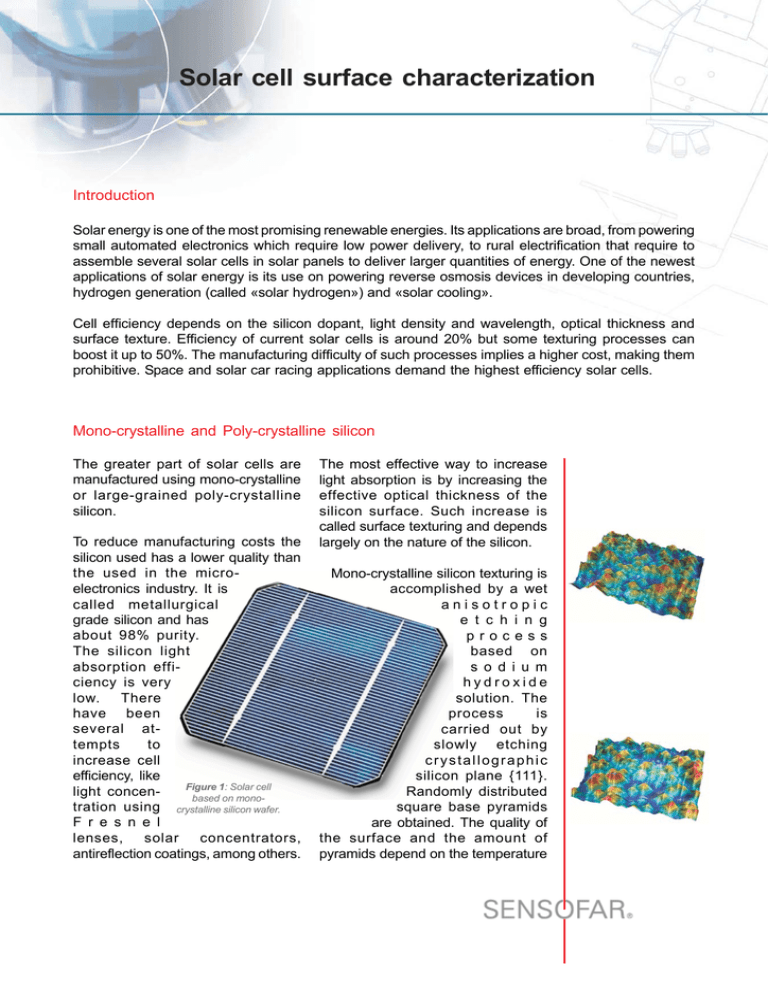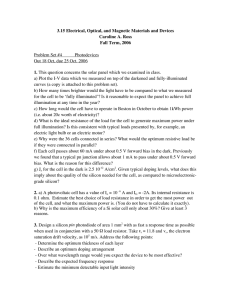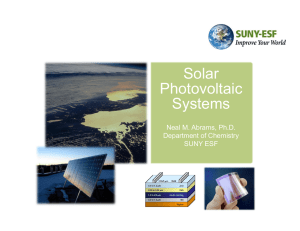Solar cell surface characterization
advertisement

Solar cell surface characterization
Introduction
Solar energy is one of the most promising renewable energies. Its applications are broad, from powering
small automated electronics which require low power delivery, to rural electrification that require to
assemble several solar cells in solar panels to deliver larger quantities of energy. One of the newest
applications of solar energy is its use on powering reverse osmosis devices in developing countries,
hydrogen generation (called «solar hydrogen») and «solar cooling».
Cell efficiency depends on the silicon dopant, light density and wavelength, optical thickness and
surface texture. Efficiency of current solar cells is around 20% but some texturing processes can
boost it up to 50%. The manufacturing difficulty of such processes implies a higher cost, making them
prohibitive. Space and solar car racing applications demand the highest efficiency solar cells.
Mono-crystalline and Poly-crystalline silicon
The greater part of solar cells are
manufactured using mono-crystalline
or large-grained poly-crystalline
silicon.
To reduce manufacturing costs the
silicon used has a lower quality than
the used in the microelectronics industry. It is
called metallurgical
grade silicon and has
about 98% purity.
The silicon light
absorption efficiency is very
low. There
have been
several attempts
to
increase cell
efficiency, like
Figure 1: Solar cell
light concenbased on monotration using crystalline silicon wafer.
F r e s n e l
lenses,
solar
concentrators,
antireflection coatings, among others.
The most effective way to increase
light absorption is by increasing the
effective optical thickness of the
silicon surface. Such increase is
called surface texturing and depends
largely on the nature of the silicon.
Mono-crystalline silicon texturing is
accomplished by a wet
anisotropic
e t c h i n g
process
based on
s o d i u m
hydroxide
solution. The
process
is
carried out by
slowly etching
crystallographic
silicon plane {111}.
Randomly distributed
square base pyramids
are obtained. The quality of
the surface and the amount of
pyramids depend on the temperature
Solar cell surface characterization
and the solution composition. The
«light trapping» effect is very effective
with such surface texture, increasing
the amount of internal reflections, and
thus the cell light absorption efficiency,
from 10 to 50 times.
In contrast, multi-crystalline silicon
texturing is not so effective because
most of the grains have incorrect
orientation. Surface texturing on this
wafers have the disadvantage that
different grains etch at different rates
giving steps at grain boundaries, this
being a problem for the subsequent
process for metal screening.
Current driving on the silicon surface
is accomplished by different
technologies. The most typical are
screen printed metal, buried contacts
and metal insulators.
Surface texture characterization
Solar cell quality control is done at the
end of the production chain, testing
each individual cell for efficiency in a
solar air mass 1.5G simulator.
Sensofar offers a solution for quality
control and production control for
some of the key steps during the
manufacturing line. The dual
technology PLμ 2300 Optical Imaging
Profiler offers the possibility to control silicon surface
texture, roughness,
pyramid statistical
characterization and
metal contact in few
seconds.
Figure 2 shows a 3D
measurement of a
mono-crystalline
silicon wafer after
pyramidal etching. In
contrast to the time,
consuming Scanning
Electron Microscope
measurement, the
wafer is placed under
the PLμ 2300 and a 3D measurement
is obtained in less than 10 seconds.
The high local slope of the pyramid
faces requires the use high numerical
aperture objectives, only available in
confocal technology. For such 3D
measure a 150X objective with a 0.95
numerical aperture was used,
reducing the field of view to few tens
of microns, similar to the field of view
Figure 2: Mono-crystalline silicon surface after
crystallographic {111} wet etching. The pyramidal
surface texture increases «light trapping» up to 50 times,
increasing the cell efficiency.
Solar cell surface characterization
of a SEM. The surface is scanned few
microns along the focus position of
the objective, collecting the confocal
images plane by plane. The result is
a SEM like image with infinite focus
and 3D information of the heights of
the pyramids.
In figure 3 a profile cut show a single
one of the segmented regions.
Figure 4 shows the segmented
topography and figure 5 the statistical
pyramid height distribution. The
histogram distribution is a key
parameter that gives information
about the number of pyramids, its
Figure 3: Profile cut of the pyramids on a mono-crystalline silicon surface.
pyramid characterization for height,
base area and face angles. For the
statistical pyramid characterization, a
special watershed segmentation
algorithm is used. This segmentation
separates each individual pyramid by
the use of the height information and
calculates area, volume, average
height and maximum height for each
Figure 4: Pyramid topographical segmentation
using a water-shed algorithm. Each pyramid is
isolated and its volume, area and height are
calculated.
uniformity, if there are non-textured
regions and if the texturing process
has created regions with different size
pyramids.
In contrast to pyramidal monocrystalline silicon texturing, a multicrystalline silicon surface is much
smoother. Heights and angles of each
Figure 5: Statistical height
distribution of the pyramids.
Solar cell surface characterization
individual grain are on the sub-micron
range, while size is several times
bigger.
Figure 6 show the result of a 3D
measurement on a mono-crystalline
The small and compact size of the
PLμ 2300 sensorhead make it the
ideal tool to be assembled in the
production chain for production control.
Figure 6: Mono-crystalline (left) and multi-crystalline (right) surface texture.
Surface roughness are compared for both texturing processes.
(left) and multi-crystalline (right)
surfaces with the same field of view.
Surface roughness parameters are
shown for comparison. Figure 7 show
a metal contact on a mono-crystalline
silicon surface. The height, area and
volume are retrieved from the 3D
information.
The easy to use and programmable
software allows the possibility to control statistical texturing parameters in
different regions of single wafers, as
well as metal contact characterization
during the same scanning process.
Sensofar-Tech, S.L.
Ctra. N-150, km. 14,5
Mòdul TR20 - IPCT
E-08227 Terrassa
T. +34 93 739 89 45
F. + 34 93 786 01 16
info@sensofar.com
www.sensofar.com
Figure 7: Conductor made by
screen printed metal.

